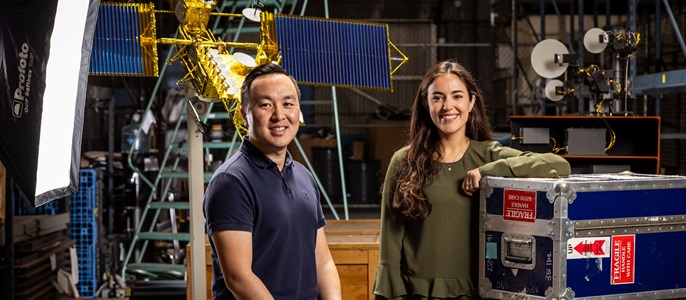Hear from the team making this mission possible. The mission is a team effort, bringing together employees from across the company.
FPA
JSS component is missing React implementation. See the developer console for more information.
By Michelle A. Monroe
Radiation Test Engineer Taylor Fry is the only former astronomy adjunct professor and a rising physicist in Northrop Grumman’s Radiation Test Operations (RTO) Laboratory born and raised in Orange County, California, Taylor graduated with a bachelor’s degree in physics from Cal Poly Pomona and a master’s degree in physics at California State University, Long Beach. He began teaching astronomy at Orange Coast College, where he enjoyed the freedom of writing his own syllabus and inspiring non-science majors to see the beauty of the universe.
“My job was basically to blow people’s minds, so I had an entire lecture on just imparting the scale of the universe. Our brains are not built to conceptualize numbers like a billion; we can understand miles and minutes but not centuries and light-years,” Taylor said. “Getting students to take a bigger perspective was life changing to them and me. It was challenging in the best way.”
After a year of teaching, though, Taylor set his sights on the aerospace industry.
“I wanted to use my talents for something big,” said Taylor, who ultimately landed a position at Northrop Grumman’s RTO Laboratory.
From Professor to Tester
Space is full of radiation from the sun and other cosmic sources that humans don’t experience on Earth because of the planet’s magnetic field. So, when engineers design and build satellites, they need to be sure the spacecraft can withstand the harsh environment by testing parts in a controlled area that simulates space.
Enter the RTO Laboratory.
Located at the company’s Space Park site in Redondo Beach, California, the RTO team conducts tests in radiation environments to assess degradation caused by natural space conditions or nuclear weapons. The lab has served customers with its own irradiators — machines that expose samples to radiation — since 1968.
“The threat never recedes so the requirements have gotten higher, and the parts have gotten more complex which means they’re more vulnerable to radiation,” Taylor said. “As technology advances and access to space gets cheaper, more and more companies want to put things in space that are novel, and they will need testing. As the threat increases, critical space systems will need not only to survive in space but also operate through anything.”
Branching Out
Since testing electrical parts is a large part of the job, most people on the RTO team have an electrical engineering background. However, Taylor’s physics background offers a unique advantage, especially given an increased interest in materials radiation testing.
“It’s not just space, it’s not just electronics, it’s a lot more variety,” Taylor said. “It’s been neat. And we’ve been developing new guidelines for that kind of materials radiation testing.”
Testing requests come from both within the company and externally, with a recent uptick in requests related to improving nuclear reactor design.
“My favorite part about this is it furthers research that can help build nuclear fission reactors which would be a game changer for the world’s energy needs,” Taylor said.
For Taylor, it’s the best of both worlds — and the perfect opportunity to do something big, just like he had always imagined.
“With radiation testing, I get to work in an engineering field building real things, but still get to have the hands-on experimentation with testing,” said Taylor. “I like adding to our knowledge. After we test, we know more about this part. It’s neat to be a scientist doing this.”
Life at Northrop Grumman
Your work at Northrop Grumman makes a difference. Whether you want to design next-generation aircraft, harness digital technologies or build spacecraft that will return humanity to the moon, you’ll contribute to technology that’s transforming the world. Check out our career opportunities to see how you can help define possible.


